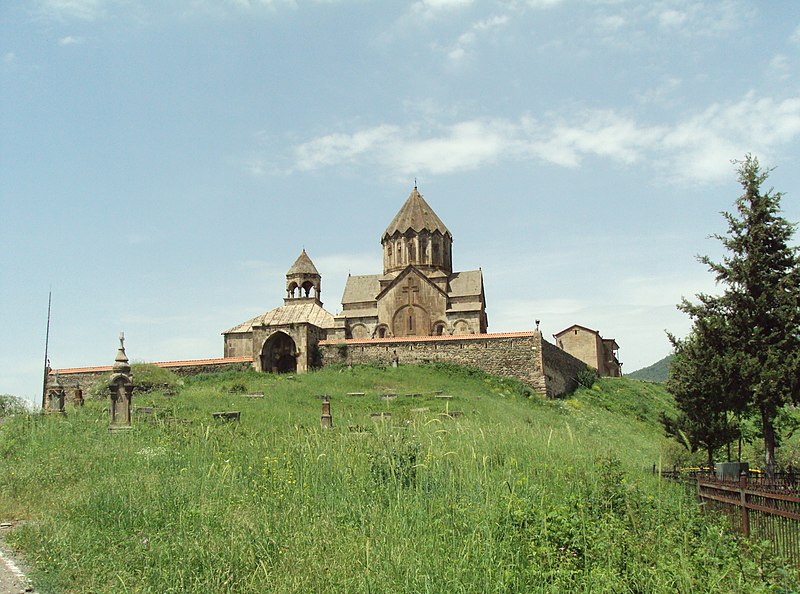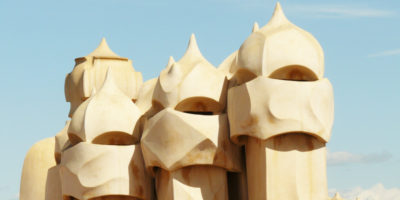
Photo by Armen Manukov from Wikimedia
Top 10 Fascinating Facts about Gandzasar Monastery/Ganzasar Bank
Gandzasar monastery is one of the most prominent architectural monuments of Artsakh. It is also a symbol of Armenian statehood in Nagorno-Karabakh. The monastery is a 13th-century Armenian Apostolic located near the village of Vank in the Martakert Province in the Kalbajar District of Azerbaijan.
The name Gandzasar means the “treasure mountain” in the Armenian language. It is believed to have originated from the tradition that the monastery was built on a hill containing ores of silver and other metals.
It is one of the most popular destinations in the Nagorno Karabakh Republic, and It attracts a big number of pilgrims and tourists from all over the world.
1. Gandzasar Monastery was Built in the Honor of John the Baptist

Photo by Clay Gilliland from Wikimedia
According to the legend, the monastery was founded on the site of the sanctuary with the skull of John the Baptist, which was brought to Artsakh by prince Asan-Jalal from Palestine.
It is believed that relics of the saint are buried under the altar of the church, which is masterly decorated with bas-reliefs with images of the Crucifixion. Other decorations include Adam and Eve and dozens of other stone figures, including sculptures of the kings of Khachen.
The church of St. John the Baptist is also known for its unique 16-ray dome illustrated with biblical images. The monastery had a rich manuscript repository, a seminary, fortifications built in the 13th century, a dining room, and a two-story school building.
2. It Served as a Political Centre
Although Gandzasar is a spiritual site, it was also used as a political center. It was the place where the movement of the struggle for freedom and independence originated.
The monastery played an important role in the battles for freedom as early as the 17th and 18th centuries. The Gandzasar’s Catholicos supported Karabakh princes in their struggle for liberation.
At the beginning of the 18th century, the leaders of the liberation movement together with the Catholicos wrote a famous letter to the Russian Emperor Peter I, in which they expressed their desire to join Russia.
3. Gandzasar Monastery was used as a School

Photo by Vahemart from Wikimedia
The monastery consists of the church of st. John the Baptist, vestibule, and other buildings within the walls of the monastery. Those buildings were once used as a school and then as homes for monks.
This complex is unique because the church and vestibule seem to have been built together but in fact, they were built separately. The walls of the church are decorated with nice ornaments none of which is repeated in Gandzasar.
The building was sponsored by Hasan Jalal Dawla prince to reflect the power and wealth of Hasan Jalalyan house.
4. It is a Major Tourist Destination
The Gandzasar Monastery is one of the most popular destinations for anyone visiting the Nagorno Karabakh Republic It attracts a big number of pilgrims and tourists from all over the world.
While a big portion of international visitors to Gandzasar are ethnic Armenians from diaspora communities in the United States, Russia, France, Iran, Lebanon, Syria, Greece, Australia, and Argentina, the number of non-Armenians has also been increasing in recent gradually.
Most international visitors see Nagorno Karabakh as a unique Christian civilization and ancient land of stunning natural beauty that has overcome incredible odds to preserve its identity, spiritual values, and independence.
5. Gandzasar Monastery is a Religious Pilgrimage Center

Photo Source: Wikimedia
Religious pilgrims are a special and new category of visitors to the monastery. They come from both Armenia and abroad, attracted primarily to Nagorno Karabakh’s key religious sites.
Apart from Gandzasar, they also are attracted to the Amaras and Dadivank monasteries which are in nearby locations. There are other monasteries that possess important relics or are associated with the lives and deeds of Christian saints.
Some pilgrims add to their itineraries the city of Shushi, the old capital of Nagorno Karabakh, which was in the hands of Azerbaijani forces during the war. The fact that Armenians regained control over the city in 1992 is considered by these pilgrims as a manifestation of divine care and direction.
6. It survived Bombing in 1991 -1992 Conflict
During the Azerbaijani aggression against Nagorno-Karabakh from 1991-1992, the monastery was attacked by the Azerbaijani army. The air attacks were deliberately carried out with the purpose of destroying the monastery.
However, the monastery largely remained intact despite sustained aerial bombardment. The locals believe that it was only through God’s miracle that the church survived the aggression.
It was during the fighting in the vicinity of the Gandzasar Monastery that the first large regiments of the Azerbaijani army were surrounded and destroyed by self-defense units of Nagorno-Karabakh.
7. Gandzasar Monastery was refurbished after the War

Photo by Yerevantsi from Wikimedia
Following the end of the 1991 – 1992 conflict, the monastery was completely restored and refurbished. The Restoration works lasted for two years, which included the restoration of the altar and tiling of the floor.
He also funded the works of upgrading the road leading to the church. Some controversy surrounded the tiling of the wall around the monastery in 2011, with critics arguing it was part historic complex.
8. Other attractions Near the Gandzasar Monastery
The Gandzasar Monastery is not the only religious and historical landmark in Nagorno Karabakh. There are many other spectacular destinations in the area with significant historical importance.
They include the Ancient City of Tigranakert, Tzitzernavank Monastery, and St. Yeghishe Arakial Monastery. Others are Dadivank Monastery, Gtichavank Monastery, Bri Yeghtze Monastery, and Gyulistan Castle.
9. The Monastery organized a Carpets blessing Ceremony
Another fascinating event associated with the Ganzasar monastery is a ceremony of blessing the Gandzasar carpets. Such a ceremony was held there on October 23, 2017. The ceremony marked the beginning of a charity project, to which the rich traditions of Armenian carpet-making began to be renewed.
Particular attention was paid to church carpets, which were made taking into account the architecture and interior decoration of each part of the monastery.
Within the framework of this project, the Megerian Carpet company made carpets specially designed for the monastery. The carpets were presented to the church, and each of the carpets has a unique design.
10. How to get to Gandzasar Monastery/Ganzasar Bank
The well-established transport infrastructure of Armenia allows getting to Gandzasar monastery very easy. one can use a private car or seek the help of various travel companies which offer regular excursions and tours to different sights of the country.

 English
English










